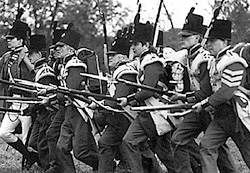The following text lays down the prescribed procedure for charging with the bayonet in the British Army.
General Orders, Horse Guards, 26th January, 1804
(National Army Museum A.N. 5904/173)
It having been represented to the Commander in Chief that some doubts are entertained in regard to the Explanation of the 17th Movement, prescribed in His Majesty's Regulations for the Inspection and Review Exercise, His Royal Highness has commanded that it shall be clearly explained to the Troops, that whenever a Battalion, or Line, charges with Bayonets, the Whole are in the first instance to port their Arms, and advance at a firm quick step, or at a steady run, if circumstances render it necessary, but in the most perfect order possible, until they reach the Enemy.
 It is at that instant that the Front Rank are necessarily to bring their Firelocks down to the Charging Position, and the Whole are to press forward with the utmost energy. The enemy being routed, it will depend on the Officer Commanding to give the Word "HALT". When the Front Rank will resume their Position of Ported Arms, and proceed as may be afterwards directed. But the word "HALT" is on no account to be given during a Charge, or as preparatory to the Front Rank bringing the Firelocks down to the Charging Position. It is therefore to be understood that in the Charge or quick Attack upon the Enemy with fixed Bayonets, either previous to, or after firing, which is usually performed at a distance of 150 or 200 yards, as the ground will admit, the Charging Position of the Front Rank is to be assumed only at the instant of Attack or Defence.
It is at that instant that the Front Rank are necessarily to bring their Firelocks down to the Charging Position, and the Whole are to press forward with the utmost energy. The enemy being routed, it will depend on the Officer Commanding to give the Word "HALT". When the Front Rank will resume their Position of Ported Arms, and proceed as may be afterwards directed. But the word "HALT" is on no account to be given during a Charge, or as preparatory to the Front Rank bringing the Firelocks down to the Charging Position. It is therefore to be understood that in the Charge or quick Attack upon the Enemy with fixed Bayonets, either previous to, or after firing, which is usually performed at a distance of 150 or 200 yards, as the ground will admit, the Charging Position of the Front Rank is to be assumed only at the instant of Attack or Defence.
By Order of His Royal Highness, The Commander in Chief, Harry Calvert, Adjutant-General of the Forces.
Printed by T.Egerton, Whitehall.
Back to Table of Contents -- First Empire #32
© Copyright 1996 by First Empire.
This article appears in MagWeb (Magazine Web) on the Internet World Wide Web.
Other military history articles and gaming articles are available at http://www.magweb.com